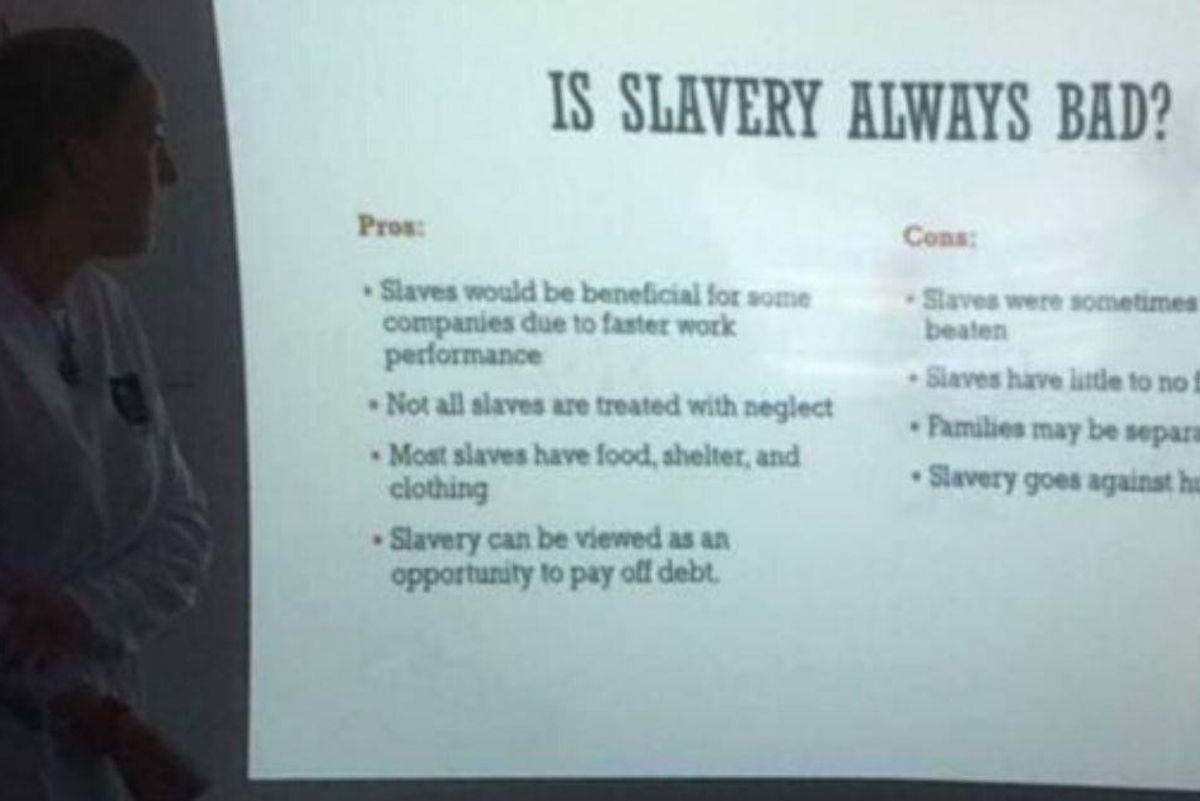A class presentation listing 'pros' and 'cons' of slavery is why we need racism education

How race and racism are handled in schools has been an issue for decades, but the debate has been pushed into the spotlight in the past couple of years as the Black Lives Matter movement has gained momentum. Hysteria over critical race theory (or what people think critical race theory is) has overtaken school board meetings and resulted in legislation governing what can and can't be talked about in the classroom when it comes to race and racism.
A viral photo of a class presentation listing the pros and cons of slavery illustrates how vital it is to incorporate racism education in schools. The watering down of American slavery has gone on for far too long, and no matter what the assignment was here, this kind of slide has no place in a classroom.
I would walk out of class.pic.twitter.com/IXcjEAnBOA— Sir James The Second\ud83c\udff3\ufe0f\u200d\ud83c\udf08 (@Sir James The Second\ud83c\udff3\ufe0f\u200d\ud83c\udf08) 1632662539
The image, which seems to have first been shared in 2016, shows what appears to be a student presenting a slide with the title, "IS SLAVERY ALWAYS BAD?" followed by a list of "pros" and "cons" of enslaving people.
According to the presentation, the pros of slavery include:
- Slaves would be beneficial for some companies due to faster work performance
- Not all slaves are treated with neglect
- Most slaves have food, shelter, and clothing
- Slavery can be viewed as an opportunity to pay off debt.
And the cons listed were:
- Slaves were sometimes harshly beaten
- Slaves have little to no freedom
- Families may be separated
- Slavery goes against human rights.
Hoo boy. Lots to unpack here.
We don't know what class this photo came from—maybe history, maybe a debate class—but it doesn't matter. There is one, and only one, correct answer to the question the slide poses. YES, slavery is always bad. End of discussion. There are things that are simply not debatable, and slavery is one of them.
But unfortunately, it's far too common for Americans to engage in these kinds of "let's weigh the pros and cons before determining if making Black people work for free, using violence and family trauma to keep them enslaved for centuries, was really as evil as it sounds" arguments. It's been happening in textbooks and classrooms throughout our history. It's wrong. It has always been wrong.
The other issue with pro/con "analysis" is that it doesn't adjust the weight of any factors.\n\nThe chart makes it look like a balanced debate - 4 up, four down. It's a bad way to show that "some businesses can make more money" is being balanced against human rights violations.— Leonard C Suskin (@Leonard C Suskin) 1632739947
We don't even have to stretch our imaginations very far to understand why it's wrong.
Imagine a slide asking, "IS GENOCIDE ALWAYS WRONG?" with a list of pros that include "A smaller population would be beneficial for some due to fewer mouths to feed" and "Many people killed in a genocide aren't tortured before they die." No. We don't do that. Never ever.
Imagine a pros and cons list like this for domestic violence. Pro: Abusers get what they want. Con: Sometimes the abused get physically injured. Ridiculous, right?
Imagine asking high schoolers to make a pros and cons list for drunk driving. No. That would be asinine.
@dril And it saves money on cabs.— Pet Food Taster (@Pet Food Taster) 1399652537
But some people treat slavery as if it's debatable how bad it was. I once had someone try to convince me that slavery wasn't all that bad because "many slaves were considered members of their owner's family and weren't mistreated." As if being enslaved was not mistreatment in and of itself. The mental gymnastics some Americans will do to make slavery sound better than it was is astounding.
My wife grew up in Alabama and their text books said slaves enjoyed being there, master threw picnics for them and treated them well. Seriously, they were taught this. In school. FFS, CRT should be taught in school, reality needs to be faced.— My dog thinks I'm cool. (@My dog thinks I'm cool.) 1632668150
The fact that this slide was made and presented to a classroom in the 21st century is an indication that education about racism in schools is necessary. This slide is racism, and the fact that that's not obvious to everyone is exactly the problem.
Pros: Employers save money\nCons: Literally a human rights violation \n\nLecturer: IDK these both seem equally valid— Ross Thompson (@Ross Thompson) 1632679665
This kind of presentation is what happens when you teach slavery as if it were just another policy decision and not the racist, dehumanizing evil driven by white supremacy and greed that it was. We need to teach history honestly and thoroughly, explaining the racist ideology that led to racist chattel slavery in the United States and the racist oppression that followed emancipation. Otherwise, we end up with this kind of whitewashed, false-equivalency pros and cons list that has no place in a civilized society.
- A school assignment asked for 3 benefits of slavery. This kid gave ... ›
- Still think the Civil War wasn't fought over slavery? The Confederate ... ›
- Hamilton's missing 'Cabinet Battle #3' addresses the slavery issue ... ›
- Student gives a good answer to an assignment on slavery - Upworthy ›
- Student gives a good answer to an assignment on slavery - Upworthy ›





 Rihanna Nails GIF
Rihanna Nails GIF

 Good luck trying to catch a gazelle.
Good luck trying to catch a gazelle. Chickens will eat just about anything.
Chickens will eat just about anything. There's actually a big difference between horses and zebras besides just the stripes.
There's actually a big difference between horses and zebras besides just the stripes. Stop Right There The End GIF by Freeform
Stop Right There The End GIF by Freeform